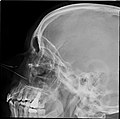| Paranasal sinuses | |
|---|---|
 Paranasal sinuses seen in a frontal view | |
 Lateral projection of the paranasal sinuses | |
| Details | |
| Identifiers | |
| Latin | sinus paranasales |
| MeSH | D010256 |
| TA98 | A06.1.03.001 |
| TA2 | 3176 |
| FMA | 59679 |
| Anatomical terminology | |
Paranasal sinuses are a group of four paired air-filled spaces that surround the nasal cavity. [1] The maxillary sinuses are located under the eyes; the frontal sinuses are above the eyes; the ethmoidal sinuses are between the eyes, and the sphenoidal sinuses are behind the eyes. The sinuses are named for the facial bones and sphenoid bone in which they are located. The role of the sinuses is still debated.





